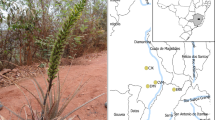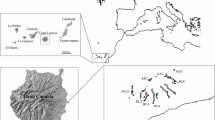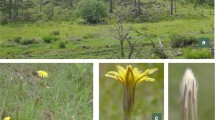Abstract
Vellozia compacta Mart. ex Schult. is a morphologically polymorphic species distributed in disjunct populations in two edaphic environments of Brazilian campos rupestres vegetation (rupestrian fields), quartzite outcrops and ferruginous outcrops (canga). These environments have extreme conditions that may lead to local adaptation, especially in canga, due to soils that have large amounts of compounds that are toxic to many plant species. We studied the genetic diversity of ten populations of V. compacta to test the hypothesis its genetic variability is highly structured due to the disjunction of campos rupestres where this species occurs, and the genetic structure is associated with the rock type of the outcrop. Populations from ferruginous outcrops presented about half the genetic diversity (average H e = 0.07) of those of quartzite populations (average H e = 0.13). The populations are divided into six genetic groups and genetic divergence among populations was very high (ΦST = 0.559). The high genetic divergence found can be explained by the disjunct distribution of the populations and the different edaphic conditions. The morphological polymorphism and high divergence among populations indicate that V. compacta might be a complex of incipient or cryptic species and its conservation is of special concern.




Similar content being viewed by others
References
Alves RJV (1994) Morphological age determination and longevity in some Vellozia populations in Brazil. Folia Geobot 29:55–59
Ayensu E (1973) Biological and morphological aspects of the Velloziaceae. Biotropica 5:135–149
Azevedo MTA, Borba EL, Semir J, Solferini VN (2007) Very high genetic variability in Neotropical myophilous orchids. Bot J Linn Soc 153:33–40
Barbará T, Martinelli G, Fay MF, Mayo SJ, Lexer C (2007) Population differentiation and species cohesion in two closely related plants adapted to neotropical high-altitude inselbergs, Alcantarea imperialis and A. geniculata (Bromeliaceae). Mol Ecol 16:1981–1992
Barbará T, Martinelli G, Palma-Silva C, Fay MF, Mayo S, Lexer C (2009) Genetic relationships and variation in reproductive strategies in four closely related bromeliads adapted to neotropical ‘inselbergs’: alcantarea glaziouana, A. regina, A. geniculata and A. imperialis (Bromeliaceae). Ann Bot 103:65–77
Borba EL, Felix JM, Solferini VN, Semir J (2001) Fly-pollinated Pleurothallis (Orchidaceae) species have high genetic variability: evidence from isozyme markers. Ann Bot 88:419–428
Borba EL, Funch RR, Ribeiro PL, Smidt EC, Silva-Pereira V (2007) Demography, and genetic and morphological variability of the endangered Sophronitis sincorana (Orchidaceae) in the Chapada Diamantina, Brazil. Pl Syst Evol 267:129–146
Brady KU, Kruckeberg AR, Bradshaw HD (2005) Evolutionary ecology of plant adaptation to serpentine soils. Ann Rev Ecol Evol Syst 36:243–266
Conceição AS, Queiroz LP, Lambert SM, Pereira ACS, Borba EL (2008) Biosystematics of Chamaecrista sect. Absus subsect. Baseophyllum (Leguminosae: Caesalpinioideae). Pl Syst Evol 270:183–207
Cruz DT, Selbach-Schnadelbach A, Lambert SM, Ribeiro PL, Borba EL (2011) Genetic and morphological variability in Cattleya elongata Barb. Rodr. (Orchidaceae), endemic to the campo rupestre vegetation in Northeastern Brazil. Pl Syst Evol 295:87–98
Doyle JJ, Doyle JL (1987) A rapid DNA isolation procedure for small quantities of fresh leaf tissue. Phytochem Bul 19:11–15
Evanno G, Regnaut S, Goudet J (2005) Detecting the number of clusters of individuals using the software STRUCTURE: a simulation study. Mol Ecol 14:2611–2620
Excoffier L, Laval G, Schneider S (2005) Arlequin ver. 3.0: an integrated software package for population genetics data analysis. Evol Bioinform Online 1:47–50
Felsenstein J (2006) PHYLIP: Phylogeny Inference Package, version 3.66, July 2006. http://evolution.gs.washington.edu/phylip.html. Accessed 25 Jan 2011
Franceschinelli EV, Jacobi CM, Drummond MG, Resende MFS (2006) The genetic diversity of two Brazilian Vellozia (Velloziaceae) with different patterns of spatial distribution and pollination biology. Ann Bot 97:585–592
Giulietti AM, Pirani JR (1988) Patterns of geographic distribution of some plant species from the Espinhaço Range, Minas Gerais and Bahia, Brazil. In: Vanzolini PE, Heyer WR (eds) Proceedings of a workshop on Neotropical distribution patterns. Academia Brasileira de Ciências, Rio de Janeiro, pp 39–69
Hamrick JL, Godt MJW (1990) Allozyme diversity in plant species. In: Brown AHD, Clegg MT, Kahler AL, Weir BS (eds) Plant population genetics, breeding, and genetic resources. Sinauer, Sunderland, pp 43–63
Hamrick JL, Godt MJW (1996) Effects of life history traits on genetic diversity in plant. Philos Trans R Soc Lond B Biol Sci 351:1291–1298
Ibisch PL, Rauer G, Rudolph D, Barthlott W (1995) Floristic, biogeographical and vegetational aspects of Precambrian rock outcrops (inselbergs) in Eastern Bolivia. Flora 190:299–314
Ibisch PL, Nowicki C, Vasquez R, Koch K (2001) Taxonomy and biology of Andean Velloziaceae: vellozia andina sp. nov. and notes on Barbaceniopsis (including Barbaceniopsis castillonii comb. nov.). Syst Bot 26:5–16
Jacobi CM, Carmo FF (2008) The contribution of ironstone outcrops to plant diversity in the Iron quadrangle, a threatened Brazilian landscape. AMBIO 37:324–326
Jacobi CM, del Sarto MCL (2007) Pollination of two species of Vellozia (Velloziaceae) from high-altitude quartzitic grasslands, Brazil. Acta Bot Bras 21:325–333
Jacobi CM, Carmo FF, Vincent RC, Stehmann JR (2007) Plant communities on ironstone outcrops: a diverse and endangered Brazilian ecosystem. Biodiv Conserv 16:2185–2200
Jacobi CM, Carmo FF, Campos IC (2011) Soaring extinction threats to endemic plants in Brazilian metal-rich regions. AMBIO 40:540–543
Jesus FF, Solferini VN, Semir J, Prado PI (2001) Local genetic differentiation in Proteopsis argentea (Asteraceae), a perennial herb endemic in Brazil. Pl Syst Evol 226:59–68
Jesus FF, Abreu GA, Semir J, Solferini VN (2009) Low genetic diversity but local genetic differentiation in endemic Minasia (Asteraceae) species from Brazil. Pl Syst Evol 277:187–196
Lambert SM, Borba EL, Machado MC (2006a) Allozyme diversity and morphometrics of the endangered Melocactus glaucescens (Cactaceae), and investigation on the putative hybrid origin of M. × albicephalus (M. ernestii × glaucescens) in Northeastern Brazil. Pl Spec Biol 26:93–108
Lambert SM, Borba EL, Machado MC, Andrade SCS (2006b) Allozyme diversity and morphometrics of Melocactus paucispinus (Cactaceae) and evidence for hybridization with M. concinnus in the Chapada Diamantina, North-eastern Brazil. Ann Bot 97:389–403
Lousada JM, Borba EL, Lovato MB (2011) Genetic structure and variability of the endemic and vulnerable Vellozia gigantea (Velloziaceae) associated with the landscape in the Espinhaço Range, in southeastern Brazil: implications for conservation. Genetica 139:431–440
Manel S, Joost J, Epperson BK, Holderegger R, Storfer A, Rosenberg MS, Scribner KT, Bonin A, Fortin MJ (2010) Perspectives on the use of landscape genetics to detect genetic adaptive variation in the field. Mol Ecol 19:3760–3772
Meimberg H, Milan NF, Karatassiou M, Espeland EK, McKay JK, Rice KJ (2010) Patterns of introduction and adaptation during the invasion of Aegilops triuncialis (Poaceae) into Californian serpentine soils. Mol Ecol 19:5308–5319
Mello-Silva R (1995) Aspectos taxonômicos, biogeográficos, morfológicos e biológicos das Velloziaceae de Grão-Mogol, Minas Gerais, Brasil. Bol Bot (USP) 14:49–79
Mello-Silva R (2005) Morphological analysis, phylogenies and classification in Velloziaceae. Bot J Linn Soc 148:157–173
Mello-Silva R, Menezes NL (1999) Two new Brazilian Velloziaceae, Vellozia auriculata and Vellozia gigantea, and a key to the related dracenoid species of Vellozia. Novon 9:536–541
Nei M (1978) Estimation of average heterozygosity and genetic distance from a small number of individuals. Genetics 89:583–590
Neves SPS (2009) Fenologia, biologia floral e polinização de espécies de Velloziaceae Endl. em área de campo rupestre na Chapada Diamantina, Bahia, Brasil. Dissertation, Universidade Estadual de Feira de Santana, Bahia
Nybom H (2004) Comparison off different nuclear DNA markers for estimating intraspecific genetic diversity in plants. Mol Ecol 13:1143–1155
Nybom H, Bartish IV (2000) Effects of life history traits and sampling strategies on genetic diversity estimates obtained with RAPD markers in plants. Perspect Plant Ecol Evol Syst 3:93–144
Oliveira PE, Gibbs PE, Bianchi M (1991) Pollination and breeding system of Vellozia squamata (Liliales, Velloziaceae)—a species of the Brazilian cerrados. Bot Acta 104:392–398
Palma-Silva C, Wendt T, Pinheiro F, Barbará T, Fay MF, Cozzolino S, Lexer C (2011) Sympatric bromeliad species (Pitcairnia spp.) facilitate tests of mechanisms involved in species cohesion and reproductive isolation in Neotropical inselbergs. Mol Ecol 20:3185–3201
Peakall R, Smouse PE (2006) GENALEX 6: genetic analysis in Excel. Population genetic software for teaching and research. Mol Ecol Notes 6:288–295
Porembski S, Barthlott W (1995) On the occurrence of a velamen radicum in Cyperaceae and Velloziaceae. Nord J Bot 15:625–629
Porembski S, Barthlott W (2000) Inselbergs: biotic diversity of isolated rock outcrops in tropical and temperate regions. Springer, Berlin
Porto ML, Silva MFF (1989) Tipos de vegetação metalófila em áreas da Serra de Carajás e de Minas Gerais. Acta Bot Bras 3:13–21
Pritchard JK, Stephens M, Donnelly P (2000) Inference of population structure from multilocus genotype data. Genetics 155:945–959
Reeves RD, Baker AJM, Borhidi A, Berazaín R (1999) Nickel hyperaccumulation in the serpentine flora of Cuba. Ann Bot 83:29–38
Ribeiro PL, Borba EL, Smidt EC, Lambert SM, Schnadelbach AS, van den Berg C (2008) Genetic and morphological variation in the Bulbophyllum exaltatum (Orchidaceae) complex occurring in the Brazilian “campos rupestres”: implications for taxonomy and biogeography. Pl Syst Evol 270:109–137
Savolainen V, Ansttet MC, Lexer C, Hutton I, Clarkson JJ, Norup MV, Powell MP, Springate D, Salamin N, Becker WJ (2006) Sympatric speciation in palms on an oceanic island. Nature 441:210–213
Sazima M (1978) Biologia floral de espécies de Velloziaceae na Serra do Cipó. Dissertation, Universidade de São Paulo, Minas Gerais
Silva RM, Fernandes GW, Lovato MB (2007) Genetic variation in two Chamaecrista species (Leguminosae), one endangered and narrowly distributed and another widespread in the Serra do Espinhaço, Brazil. Can J Bot 85:629–636
Slatkin M (1995) A measure of population subdivision based on microsatellite allele frequencies. Genetics 139:457–462
Smith LB, Ayensu ES (1976) A revision of American Velloziaceae. Smithson Contrib Bot 30:1–172
Tamura K, Dudley J, Nei M, Kumar S (2007) MEGA4: molecular evolutionary genetics analysis (MEGA) software version 4.0. Mol Biol Evol 24:1596–1599
Teixeira WA, Lemos Filho JP (1998) Metais pesados em folhas de espécies lenhosas colonizadoras de uma área de mineração de ferro em Itabirito, Minas Gerais. Rev Árvore 22:381–387
Turner TL, Von Wettberg EJ, Nuzhdin SV (2008) Genomic analysis of differentiation between soil types reveals candidate genes for local adaptation in Arabidopsis lyrata. PLoS ONE 3:e3183
Turner TL, Bourne EC, Von Wettberg EJ, Hu TT, Nuzhdin SV (2010) Population resequencing reveals local adaptation of Arabidopsis lyrata to serpentine soils. Nat Genet 42:260–263
Ungerer MC, Johnson LC, Herman MA (2008) Ecological genomics: understanding gene and genome function in the natural environment. Heredity 100:178–183
Vekemans X, Beauwens T, Lemaire M, Roldan-Ruiz I (2002) Data from amplified fragment length polymorphism (AFLP) markers show indication of size homoplasy and of a relationship between degree of homoplasy and fragment size. Mol Ecol 11:139–151
Viana PL, Lombardi JA (2007) Florística e caracterização dos campos rupestres sobre canga na Serra da Calçada, Minas Gerais, Brasil. Rodriguésia 58:159–177
Volis S (2011) Adaptive genetic differentiation in a predominantly self-pollinating species analyzed by transplanting into natural environment, crossbreeding and QST–FST test. New Phytol 192:237–248
Wright JW, Stanton ML (2007) Collinsia sparsiflora in serpentine and non-serpentine habitats: using F2 hybrids to detect the potential role of selection in ecotypic differentiation. New Phytol 173:354–366
Yeah RC, Yang RC, Boyle TBJ, Ye ZH, Mao JX (1997) POPGENE, the User-Friendly Shareware for Population Genetic Analysis. http://www.ualberta.ca/~fyeh/popgene.html. Accessed 25 Jan 2011
Acknowledgments
We thank P. Viana, N. Mota, R. Milagres, E. Smidt, V. Silva-Pereira, and C. Veloso for help with population sampling, and P. Viana and R. Mello-Silva for identification of plant material. This study was funded by projects from the Conselho Nacional de Desenvolvimento Científico e Tecnológico (CNPq) and the Fundação de Amparo à Pesquisa do Estado de Minas Gerais (FAPEMIG), Brazil. J. Lousada received a fellowship from CNPq. M. Lovato and E. Borba are supported by productivity grants from CNPq.
Author information
Authors and Affiliations
Corresponding author
Rights and permissions
About this article
Cite this article
Lousada, J.M., Lovato, M.B. & Borba, E.L. High genetic divergence and low genetic variability in disjunct populations of the endemic Vellozia compacta (Velloziaceae) occurring in two edaphic environments of Brazilian campos rupestres . Braz. J. Bot 36, 45–53 (2013). https://doi.org/10.1007/s40415-013-0001-x
Received:
Accepted:
Published:
Issue Date:
DOI: https://doi.org/10.1007/s40415-013-0001-x




